Wildflowers, Grasses and Other Nonwoody Plants
Media

Species Types
Scientific Name
Anemone canadensis
Description
White anemone is a showy native wildflower with interesting, deeply toothed leaves. Often occurring in colonies, it spreads easily (even aggressively) from rhizomes and is sometimes cultivated in wildflower gardens.
Media

Species Types
Scientific Name
Thalictrum thalictroides
Description
Rue anemone is a common and beloved spring wildflower. It blooms March–June. It and other woodland wildflowers require a forest habitat to survive, so they depend on the oaks, hickories, maples, and other trees that surround them.
Media
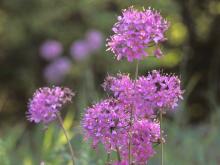
Species Types
Scientific Name
Allium stellatum
Description
Wild onion is edible and is also favored by native-plant gardeners, who enjoy its showy umbels of pink flowers and tolerance of dry, rocky sites. This Ozark species blooms in summer and fall.
Media
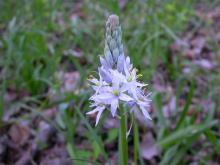
Species Types
Scientific Name
Camassia scilloides
Description
In spring, wild hyacinth bears an elongated cluster of pale blue flowers with prominent anthers that sway on stalks up to 2 feet tall.
Media

Species Types
Scientific Name
Liatris aspera
Description
Rough blazing star is fairly common and scattered nearly statewide. To distinguish between Missouri’s nine species in the genus Liatris, start by noting details of the flower structure. It’s not hard when you know what to look for.
Media
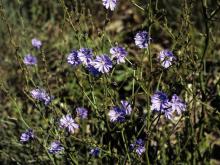
Species Types
Scientific Name
Cichorium intybus
Description
In summer and fall, the pretty blue flowers of chicory decorate roadsides and other disturbed areas. This weedy member of the aster family was introduced from Europe long ago. Its roots have been used as a coffee substitute.
Media
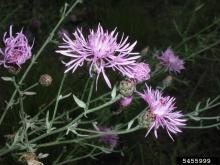
Species Types
Scientific Name
Centaurea stoebe
Description
Spotted knapweed is an invasive plant that outcompetes native communities, takes over pastureland, and even beats back invasive sericea lespedeza! It has arrived in our state. Let’s prevent its spread.
Media
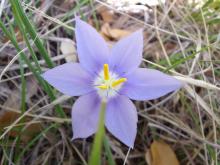
Species Types
Scientific Name
Nemastylis geminiflora
Description
Celestial lily, in the iris family, blooms only in the morning. Its showy, lavender-blue flowers shine like six-pointed stars on glades and prairies in southern Missouri and the eastern Ozarks.
Media

Species Types
Scientific Name
Geranium maculatum
Description
Called “crane’s bill” for its sharply pointed seed capsules, wild geranium is a gardening favorite, and there are cultivated varieties of this woodland wildflower bred for unique petal and leaf colors.
Media
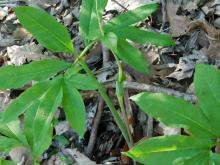
Species Types
Scientific Name
Arisaema dracontium
Description
What could be cooler than finding a green dragon? This leafy green plant with a long, noodly spadix is closely related to Jack-in-the-pulpit. It occurs in the same habitats but is less common and easily overlooked.
See Also
About Wildflowers, Grasses and Other Nonwoody Plants in Missouri
A very simple way of thinking about the green world is to divide the vascular plants into two groups: woody and nonwoody (or herbaceous). But this is an artificial division; many plant families include some species that are woody and some that are not. The diversity of nonwoody vascular plants is staggering! Think of all the ferns, grasses, sedges, lilies, peas, sunflowers, nightshades, milkweeds, mustards, mints, and mallows — weeds and wildflowers — and many more!





















